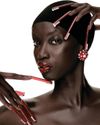With its ever-expanding legalization, marijuana has gained mainstream acceptance. But do we really know it’s safe? asks Hannah Wallace.

Last year, Oregon became the fourth state to legalize the recreational use of marijuana. In my hometown of Portland, people began lighting up on street corners, friends threw pot-themed dinner parties, and I heard whispers about a chef who hand-delivers salted caramel medibles (medical-cannabis edibles).
Whenever my husband, an unapologetic marijuana enthusiast, invites me to join him, I decline. Past experiments always gave me a sense of creeping agitation rather than euphoria. I struggle with insomnia, however, and my cocktail of remedies—valerian, wine, and Ambien—has become less and less reliable. Which is how I find myself one recent afternoon at Farma, a dispensary a mile from my house, admiring buds with names like Island Sweet Skunk and Dogwalker that are displayed beneath glass like so many exquisite chocolates. “I’m looking for something that will help me sleep—an indica?” I stammer, naming the strain that I’ve read delivers a calming high (another, sativa, has a reputation for working as a stimulant).
“We don’t classify cannabis that way,” my budtender, a slender young beauty, tells me crisply. “It’s the terpenes that are important.” Terpenes, she explains, are the aromatic oily compounds that confer character on each strain of marijuana and are believed to be responsible for particular effects. So while every label at Farma lists the percentages of tetrahydrocannabinol (THC), pot’s main psychoactive compound, and cannabidiol (CBD), the medicinal element that eases pain and anxiety but won’t get you high, terpenes are the ingredient of the moment. My attendant selects a glass jar and waves it under my nose. “I’d try Blueberry Malawi combined with Harlequin,” she cheerfully suggests.
This story is from the December 2016 edition of Vogue.
Start your 7-day Magzter GOLD free trial to access thousands of curated premium stories, and 9,000+ magazines and newspapers.
Already a subscriber ? Sign In
This story is from the December 2016 edition of Vogue.
Start your 7-day Magzter GOLD free trial to access thousands of curated premium stories, and 9,000+ magazines and newspapers.
Already a subscriber? Sign In

FINAL CUT
\"WE WANT YOU TO GO FOR IT!\" ANNA TOLD ME

SCREEN TIME
Three films we can't wait to see.

Impossible Beauty
Sometimes, more is more: Surreal lashes and extreme nails put the fierce back in play

Blossoms Dearie
Dynamic, whimsical florals and the humble backdrops of upstate New York make for a charming study in contrasts.

HOME
Six years ago, Marc Jacobs got a call about a house designed by Frank Lloyd Wright. Making it his own, he writes, would be about love, commitment, anxiety, patience, struggle, and, finally, a kind of hard-fought, hard-won peace.

GIRL, INTERRUPTED
Anna Weyant found extraordinary fame as an artist before she had reached her mid-20s. Then came another kind of attention. Dodie Kazanjian meets the painter at the start of a fresh chapter

ROLE PLAY
Kaia Gerber is someone who likes to listen, learn, read books, go to the theater, ask questions, have difficult conversations, act, perform, transform, and stretch herself in everything she does. That she's an object of beauty is almost beside the point.

CALLAS SHEET
Maria Callas's singular voice made her a legend on the stage. In a new film starring Angelina Jolieand on the runwaysthe romance continues.

BOOK IT
A preview of the best fiction coming

GLOBAL VISTAS
Three new exhibitions offer an expansive view.